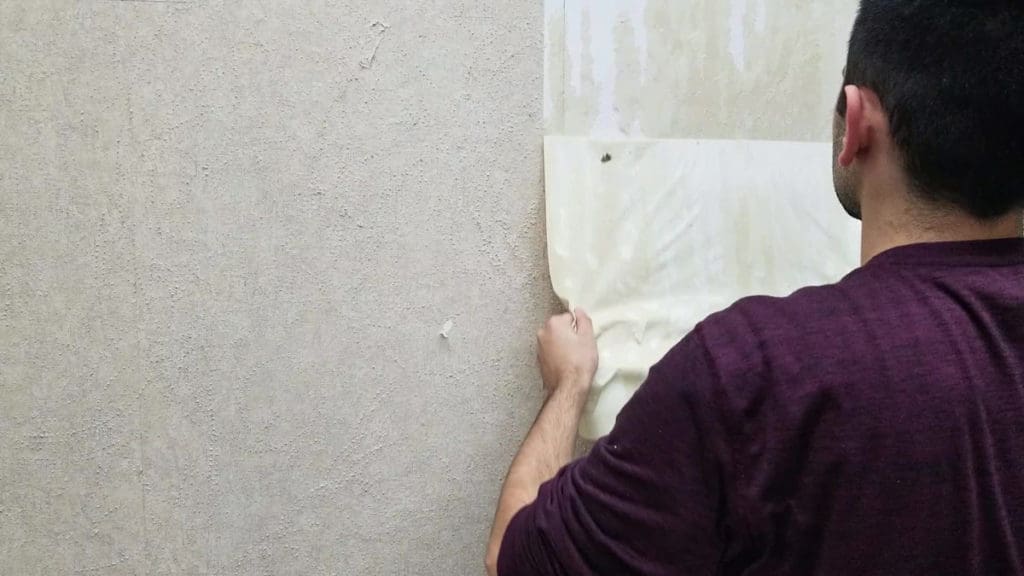Options For Removing Wallpaper
Some may rent a steamer because they’ve heard it makes the process easy and quick. Consider the following:
- First, the issue of cost. Unless you own a wallpaper steamer already, you will have to rent it (about $30 a day) or buy an inexpensive DIY unit for about $50.
- Next, steamers can be messy and difficult to use. In addition to the wallpaper that has been removed, steamers add a ton of moisture to the room you are working in. They produce steam from hot water so you have to wear protective gloves.
- Finally, they might add too much moisture to the wall and actually damage the drywall or plaster if you are not careful.
The truth is, wallpaper removal can be straightforward and simple if you use today’s best practices to accomplish it.
What Type Of Surface Is The Wallpaper Installed On?
This is important to know because removing wallpaper means you will be applying moisture that will be absorbed by the wall structure. If the wall is plaster or paneling, they can safely absorb more water than drywall, or gypsum board. Once wet, the paper face of drywall can be easily damaged if extra care is not taken during the wallpaper removal process.
How To Determine If You Have Drywall Or Something Else
The easiest way to see what type of wall structure you have is to remove a light switch or outlet cover on the wall (make sure that the power is turned off first). Once removed, you can count the layers of wallpaper and see if the wall substrate is drywall, plaster, or wood.
Gather The Right Tools And Supplies
Removing wallpaper doesn’t require a lot of special tools, but you need to make sure that you have the correct items on hand. Collect these tools before you start and get the job done right the first time:
- Drop cloths
- Step ladder
- Trash bags to dispose of old wallpaper
- Small bucket of water and sponge
- ROMAN Wallpaper Scoring Tool – Contains small sharp wheels that puncture the surface of the wallpaper.
- ROMAN Wallpaper Scraper – Has a perfectly honed blade that is preset to the best angle to remove wallpaper without damaging the wall.
- ROMAN Gel Wallpaper Remover – A no-drip formula that keeps the remover on the wall longer, which makes it effective in taking off hard to remove wallpaper.
For small jobs, you can purchase the ROMAN Wallpaper Removal Kit, which has everything you need and it will be safer, easier to use, and less expensive than a wallpaper steamer.
Start Stripping The Wallpaper From The Walls
Using a specially-formulated liquid wallpaper remover is the most economical method to take down the old paper and eliminate the need for a steamer. The remover does the hard work of heavy scraping – even with multiple layers of wallpaper.

It is always recommended to start the process with a test area to anticipate any problems.
- Using the scoring tool, roll it over an area about 2’ square. Do not apply too much pressure. You only need to score 1 layer at a time.
- Spray gel remover over the area, keeping it moist but not soaked.
- Allow 15 minutes for the gel to dissolve the old adhesive.
- Start at an edge and peel off the old paper. It should come off easily which will give you an idea of how well the paper has adhered to the layers below it. You may find that all the layers come off at the same time. If not, be patient and repeat this process for each layer until you reach the actual wall surface.
Once the test area has been removed, you will have a good idea of how you will need to proceed with the rest of the removal process. Continue scoring, spraying, and scraping until complete.
Here are some additional helpful tips:
- Turn off the electricity to the room you are working in.
- Work in sections about 4’ wide so the remover doesn’t dry out.
- Turn off fans and air vents to avoid drying the remover out.
Preparing The Wall For New Wallpaper
Once all the old wallpaper has been removed, allow the walls to dry for at least 24 hours. Now you can begin the process of preparing to install new wallpaper.
- Repair any damaged wall surfaces.
- Sand walls smooth and wipe clean with lightly dampened sponge.
- Allow another 24 hours for the walls to dry.
- Apply a primer to the wall before hanging the new paper.
The Best Source For Wallpaper Removal Supplies
ROMAN Products leads the industry as the premier manufacturer of wallpaper primers, adhesives, and removal products. Our products are available in stores throughout the U.S. as well as on many continents around the world through our distributors.
Contact us today to speak with one of our experienced customer service staff and let us help you get off to a great start on your next wallpaper project.









